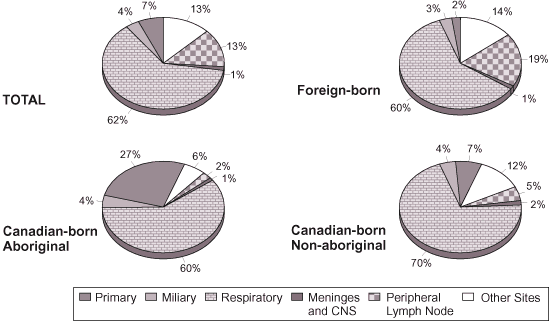Common menu bar links
Institutional links
Diseases & Conditions
Health & Safety
Research & Statistics
Agency Information
Search Box
E-mail this page
Tuberculosis in Canada 1997
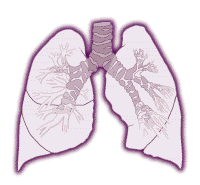
|
|
|
|
|
|
| FIGURES
|
|
|
Reported new active and relapsed tuberculosis incidence rate per 100,000 - Canada: 1924-1997 |
|
|
Reported new active and relapsed tuberculosis cases and incidence rate per 100,000 - Canada: 1980-1997 |
|
|
Reported new active and relapsed tuberculosis incidence rate per 100,000 by age group - Canada: 1982-1997 |
|
|
Distribution of reported new active and relapsed tuberculosis cases by origin - Canada: 1980 and 1997 |
|
|
Reported new active and relapsed tuberculosis incidence rate per 100,000 by main diagnostic site - Canada: 1987-1997 |
|
|
Distribution of reported new active and relapsed tuberculosis cases by origin - provinces/territories: 1997 |
|
|
Reported new active and relapsed tuberculosis cases by age group and origin - Canada: 1997 |
|
|
Distribution of reported new active and relapsed tuberculosis cases by origin and main diagnostic site - Canada: 1997 |
|
| TABLES
|
|
|
Table 1A |
Reported new active and relapsed tuberculosis cases and incidence rate per 100,000 - Canada and provinces/territories: 1987-1997 |
|
Table 1B |
Reported new active tuberculosis cases and incidence rate per 100,000 - Canada and provinces/territories: 1987-1997 |
|
Table 1C |
Reported relapsed tuberculosis cases and incidence rate per 100,000 - Canada and provinces/territories: 1987-1997 |
|
Table 2A |
Reported new active and relapsed tuberculosis cases and incidence rate per 100,000 by age group - Canada: 1987-1997 |
|
Table 2B |
Reported new active and relapsed tuberculosis cases and incidence rate per 100,000 by age group - males - Canada: 1987-1997 |
|
Table 2C |
Reported new active and relapsed tuberculosis cases and incidence rate per 100,000 by age group - females - Canada: 1987-1997 |
|
Table 3 |
Reported new active and relapsed tuberculosis cases by birthplace - Canada: 1987-1997 |
|
Table 4 |
Reported new active and relapsed tuberculosis cases and incidence rate per 100,000 by main diagnostic site - Canada: 1987-1997 |
|
Table 5A |
Reported new active and relapsed tuberculosis cases and incidence rate per 100,000 by age group - Canada and provinces/territories: 1997 |
|
Table 5B |
Reported new active and relapsed tuberculosis cases and incidence rate per 100,000 by age group - males - Canada and provinces/territories: 1997 |
|
Table 5C |
Reported new active and relapsed tuberculosis cases and incidence rate per 100,000 by age group - females - Canada and provinces/territories: 1997 |
|
Table 6 |
Reported new active and relapsed tuberculosis cases and incidence rate per 100,000 by birthplace - Canada and provinces/territories: 1997 |
|
Table 7 |
Reported new active and relapsed tuberculosis cases and incidence rate per 100,000 by main diagnostic site - Canada and provinces/territories: 1997 |
|
Table 8 |
Reported new active and relapsed tuberculosis cases by birthplace, sex and age group - Canada: 1997 |
|
Table 9 |
Reported new active and relapsed tuberculosis cases and incidence rate per 100,000 by age group and main diagnostic site - Canada: 1997 |
|
Table 10 |
Reported new active and relapsed tuberculosis cases by birthplace and main diagnostic site - Canada: 1997 |
|
Table 11 |
Reported new active and relapsed tuberculosis cases by birthplace and activity status - Canada: 1997 |
|
Table 12 |
Reported new active and relapsed tuberculosis cases by bacillary status - Canada and provinces/territories: 1997 |
|
Table 13 |
Reported new active and relapsed tuberculosis cases by bacillary status and birthplace - Canada: 1997 |
|
Table 14 |
Reported new active and relapsed tuberculosis cases by bacillary status and main diagnostic site - Canada: 1997 |
|
Table 15 |
Reported New Active and Relapsed Tuberculosis Cases by Bacillary Status and Main Diagnostic Site - Canada and Provinces/Territories: 1997 |
|
Table 16 |
Reported new active and relapsed tuberculosis cases by birthplace and bacillary status - Canada and provinces/territories: 1997 |
|
Table 17 |
Reported new active and relapsed tuberculosis cases by method of detection - Canada and provinces/territories: 1997 |
|
Table 18 |
Reported new active and relapsed tuberculosis cases by method of detection and birthplace - Canada: 1997 |
|
Table 19 |
Reported new active and relapsed foreign-born tuberculosis cases by birthplace and year of arrival in Canada: 1997 |
|
Table 20 |
Reported new active and relapsed foreign-born tuberculosis cases by immigration status - Canada and provinces/territories: 1997 |
|
Table 21 |
Reported relapsed tuberculosis cases by length of inactive interval - Canada and provinces/territories: 1997 |
|
Table 22 |
Reported new active and relapsed tuberculosis cases and number of diagnoses by main diagnostic site - Canada: 1997 |
|
Table 23 |
Reported new active and relapsed tuberculosis cases reported in 1997 who died in 1997, by cause of death - Canada and provinces/territories: 1997 |
|
Table 24 |
Reported new active and relapsed tuberculosis cases reported in 1997 who died in 1997, by age group and sex - Canada: 1997 |
|
Table 25 |
Reported new active and relapsed tuberculosis cases by HIV status - Canada and provinces/territories: 1997 |
|
APPENDICES |
|
|
Appendix 1A |
Population estimates by sex and age group - Canada and provinces/territories: 1997 |
|
Appendix 1B |
Population estimates by Canadian-born origin and foreign-born birthplace - Canada and provinces/territories: 1997. |
|
Appendix 2 |
Active Tuberculosis Report Form - New and Relapsed Cases |
|
Appendix 3 |
Technical Notes Methodology and Data Quality
Report Data
Collection Definition of
Terms
Tuberculosis
Registry |
INTRODUCTION
This is the third annual report on tuberculosis morbidity and mortality published by Tuberculosis Prevention and Control following the transfer of responsibility for the Canadian Tuberculosis Reporting System (CTBRS) from Statistics Canada to Health Canada.
The annual reports on tuberculosis morbidity and mortality have undergone and will continue to have revisions in format and content from year to year in response to changes in the epidemiology and treatment of tuberculosis. Changes to the report this year include modifications to the order of main diagnostic site (hierarchy), distribution of foreign-born cases by WHO region, inclusion of immigration status for foreign-born cases and inclusion of HIV status.
Prior to 1966, the reports focused on the characteristics of patients hospitalized in tuberculosis institutions. However, with the discovery and development of new antituberculosis drugs, more and more persons with active tuberculosis were treated as outpatients. Statistics on these patients were then included in annual reports.
To reflect the continuing decrease in institutional treatment, the reports began in 1975 to combine previously separate data on inpatients and outpatients. From 1976 onward, data on facilities and services in tuberculosis institutions were no longer included; since then, reports have presented data on all reported cases of tuberculosis in the population, irrespective of where treatment occurs.
Starting with the 1977 data year, reports were developed cooperatively by Statistics Canada, the Canadian Lung Association and provincial and territorial offices of tuberculosis control, and contained information essential for the surveillance and control of tuberculosis in Canada.
As a result of a review of the national tuberculosis surveillance system conducted jointly in 1996 by the directors of the provincial and territorial tuberculosis control programs and Health Canada, the reporting form was revised for the 1997 data year to include additional information relevant to tuberculosis prevention and control. The principal changes include the addition of data items on the immigration status for foreign-born cases and HIV status (see reporting form in Appendix 2). The annual report format was revised in 1997 to include tables with this new information.
EXECUTIVE SUMMARY
In 1997, a total of 1,975 cases of new active and relapsed tuberculosis (TB) cases was reported to the Division of Tuberculosis Prevention and Control from the ten provinces and two territories. This number represents an increase of 5.7% from 1996 and is the highest total since 2,074 cases were reported in 1994. New active cases made up the vast majority (90%) of the case notifications in 1997, with relapsed cases accounting for the other 10%.
Seven of the reporting jurisdictions had case rates below the national rate of 6.6 per 100,000 (Alberta, New Brunswick, Newfoundland, Nova Scotia, Prince Edward Island, Quebec and the Yukon Territory) and four of them (New Brunswick, Nova Scotia, Prince Edward Island and the Yukon Territory) reported fewer than 10 cases each. The three most populous provinces of Ontario, Quebec and British Columbia, which collectively make up 75% of Canada's population, accounted for 77% of the total number of reported cases in 1997. Compared with the previous year, seven reporting jurisdictions (Manitoba, New Brunswick, Newfoundland, Nova Scotia, the Northwest Territories, Ontario and the Yukon Territory) reported a decrease in case numbers and rates. The overall increase in case notifications was due mainly to the increases experienced in Quebec, Alberta and British Columbia.
By age group, individuals aged 25 to 34 years made up the largest number of reported cases, accounting for 19% of the total. However, the corresponding case rate of 8.2 per 100,000 for this age group was surpassed by the age-specific rates of 8.8, 11.7 and 18.0 per 100,000 for those in the older age groups of 55 to 64, 65 to 74 and greater than 74 years, respectively.
Over time, the trends with respect to reported TB cases by birthplace have changed. From 1987 to 1997, the number of cases among Canadian-born non-Aboriginal individuals decreased by 44% (720 to 400 cases) while that among Aboriginals decreased by 26% (384 to 283 cases). During the same time period, the number of cases among foreign-born persons increased by 46% (868 to 1271 cases). In 1987, the proportions of all TB cases that were Canadian-born non-Aboriginal, Aboriginal and foreign-born were 37%, 19% and 44%, respectively. By 1997, these proportions had decreased among Canadian-born non-Aboriginals and Aboriginals to 20% and 14% respectively, whereas among the foreign-born the proportion had increased to 64%. Of note is that 38% of all the foreign-born TB cases reported in 1997 arrived in Canada in 1993 or later.
With regard to the distribution of TB cases by birthplace across the country in 1997, the provinces of Ontario, British Columbia and Alberta each reported that over 60% of their TB cases were foreign-born, particularly Ontario in which the proportion was 85%. In the Northwest Territories, Saskatchewan and Manitoba, TB cases of Aboriginal origin contributed the largest proportion to their respective total caseloads.
When age is considered, Canadian-born non-Aboriginal TB cases were relatively older than foreign-born and Aboriginal TB cases. The median age of Canadian-born non-Aboriginal TB cases was 58 years, while those of the foreign-born and Aboriginal TB cases were 43 and 32 years, respectively.
Overall, respiratory TB was the main diagnostic site for 62% of the reported cases in 1997. A larger proportion of Canadian-born non-Aboriginal TB cases had respiratory TB (70%) compared with that among both the Aboriginal and foreign-born cases (60%). Overall, TB of the peripheral lymph nodes was the second most commonly reported diagnostic site, with almost half of all such cases occurring in the foreign-born originating in the Western Pacific region of the world. This diagnostic site accounted for 19% of all foreign-born TB cases. Among the Aboriginal TB cases, primary TB accounted for the most significant proportion (27%) of all notifications after respiratory TB.
A total of 1,782 of the 1,975 reported TB cases (90%) were laboratory confirmed. Of the 1,230 respiratory cases, 54% were smear (microscopy) positive and 84% were culture positive.
The majority of reported TB cases (79%) were detected through medical investigation of symptoms.
In recognition of the importance of the interaction of HIV infection with TB, collection of HIV status was added to the national TB surveillance system, beginning with cases for 1997. The analysis of this variable indicated that HIV status was unknown for 94% of the reported TB cases. Further collaborative efforts with each of the provincial and territorial TB control programs will be necessary to gain a better understanding of the extent of TB/HIV coinfection in Canada.
Of the 1,975 cases reported in 1997, 120 were reported to have died. Of these deaths, for 27 (23%) TB was reported as the underlying cause of death and for 42 (35%) TB was reported as contributing to death, but not as the underlying cause. It should be noted that the number of reported TB related deaths is an underestimate, as it includes only known deaths at the time of reporting.
FIGURES
|
Figure 1 |
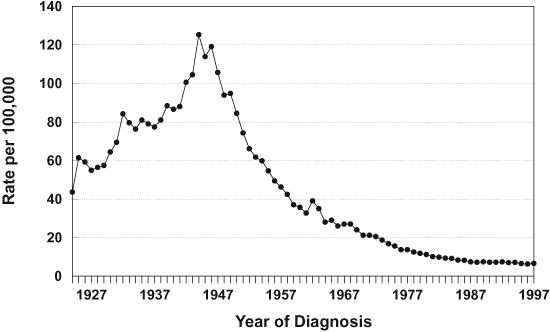 |
|
Figure 2 |
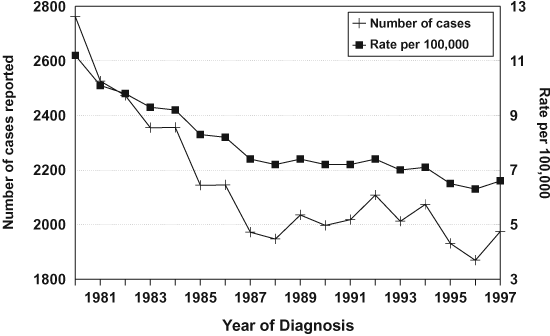 |
|
Figure 3 |
 |
|
Figure 4 |
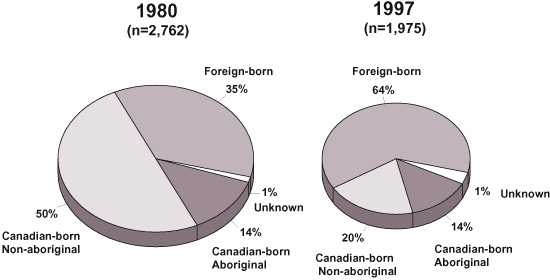 |
|
Figure 5 |
 |
|
Figure 6 |
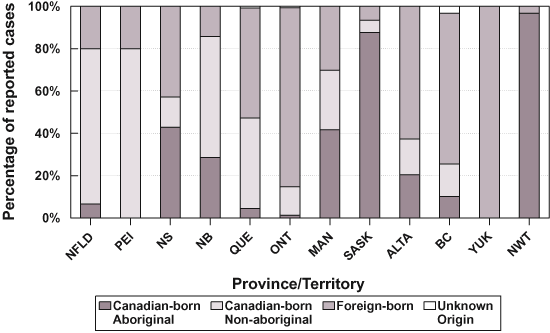 |
|
Figure 7 |
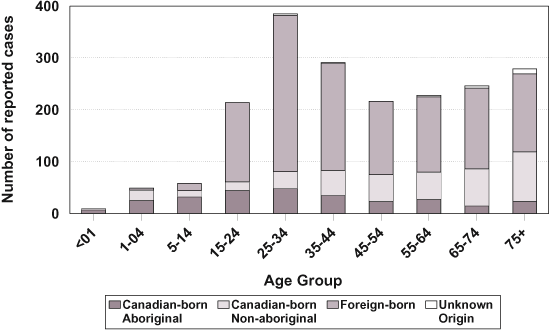 |
|
Figure 8 |
|
HOW TO REACH US
For more information, copies of this report or other related reports, please contact:
Tuberculosis
Prevention and Control Internal Postal Address: 0900B-1
Telephone:
(613) 941-0238 The following figures, tables and explanatory text were prepared by:
Penny
Nault
Melissa
Phypers, MSc
ACKNOWLEDGEMENT
The authors would like to acknowledge the Provincial/Territorial Tuberculosis Programs and their teams for their contribution to and participation in the Canadian Tuberculosis Reporting System (CTBRS). The authors would also like to thank the Scientific Publication and Multimedia Services Unit, Public Health Agency of Canada, for its assistance in preparing this report. Published by authority of the Minister of Health © Minister of Public Works and Government Services Canada 2002 This publication can be made available in alternative formats upon request.
|

